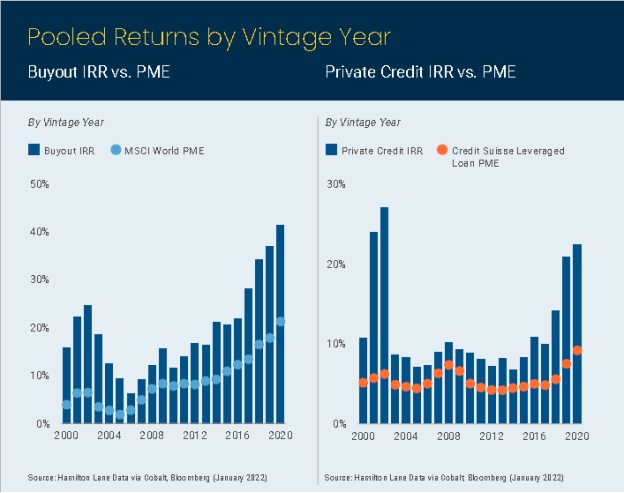Alt Investments
The Evidence Is In: Private Markets Beat Listed Equities

Data shows, the firm says, that private market investing, while less liquid, comes with superior yield and outpaced the results of listed equities. There appears as yet no end in sight to enthusiasm for sectors such as venture capital, private equity and credit.
Nearly $2 trillion of private assets, which were held by high net worth investors in 2021, have outperformed returns of listed equities, a situation likely to be compelling for people fretting about market gyrations and high inflation, a survey shows.
New York-listed investment firm Hamilton Lane, with $851 billion in assets under management and supervision, said in a report that private equity generated an extra 83 cents per dollar invested since 2017. Private real estate and credit, with significantly lower risk profiles than equity strategies, have also done “remarkably well,” the firm said.
There has been a steady drum-beat of commentary on and advocacy for private market investing over recent years. More than a decade of ultra-low official interest rates – now slowly starting to change – has crushed yields on conventional equities and government bonds. This has encouraged an influx to areas such as private equity, venture capital and forms of real estate. Investors have had to tolerate the lower liquidity of these investments in exchange for superior returns. A cluster of firms, such as CAIS and iCapital, among others, have also developed platforms to make it easier for investors to tap into previously hard-to-enter sectors.
“The global financial markets continue along a trend of rapid change that we’ve experienced during the last two years of the pandemic,” Mario Giannini, CEO of Hamilton Lane, said.
Hamilton Lane’s report draws from its database covering more than $15 trillion of assets and 45,000 funds.
“We’re examining what’s driven outperformance of late, what factors are disrupting and transforming the private markets, as well as what the investor experience could be going forward – particularly as the asset class continues to expand its investor base into the private wealth market,” Giannini said.
In a longer-term picture of private equity’s performance vis a vis public markets, the chart below shows pooled average buyout returns, which have outperformed in every single one of the past 20 vintage years and by an average of more than 1,000 basis points. Private credit also outperformed in every vintage year over the last 20. These charts show vintage years and public market equivalent (PME) – a measurement accepted by investors as the most appropriate way to benchmark returns, Hamilton Lane said. (Internal rates of return account for the complex timings of private equity deals and are not strictly comparable with those of listed equities, but the PME measure is a rough equivalent.)
Performance of private markets vs public markets

The firm also tracked the opportunities available for private investing. Fundraising has hit a record, on track for a 25 per cent jump from 2020 to 2021.
The firm said that it had identified a trend for 2022 dubbed the “15/15 club” – an estimation that at least 15 buyout managers are seeking to raise $15 billion or more in the coming year. Taking into account the fact that the managers may outpace their stated targets and the previous fund sizes of these managers, this number could top roughly $300 billion – 50 per cent above the level in 2020.
Access to private markets is widening. The number of smaller institutional and HNW investors taking part in private markets increased again in 2021.